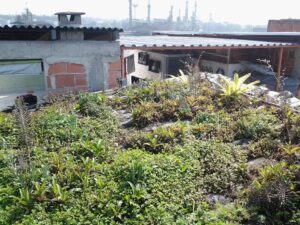Favela fights Urban Heat Islands with Green Canopy
By Matheus Bechtlufft Cardoso
Introduction
As global warming increasingly becomes a concern, cities around the world set environmental goals to mediate the effects of rising temperatures, especially in Urban Heat Islands (UCI); i.e. urban areas that have significantly higher temperatures than surrounding areas, typically in dense metropolitan cores. In Rio de Janeiro, on the other hand, the peripheries have higher average temperatures than the urban core due to the density of informal settlements, known as favelas. However, as arenas of insurgent citizenship (Holston, 2008), favela residents often produce spontaneous solutions to urban problems, including UCI. One example is the Green Roof Favela initiative founded in 2014 by Luis Cassiano Silva, a resident of the favela of Parque Arará, with the simple goal of transforming urban heat islands “through a refreshing and soothing ‘green canopy’” (RioOnWatch, 2018). Green roofs are widely used in Europe to combat CO2 emissions and improve air quality, but they also improve quality of life by reducing rainwater runoff, which is especially important in underserved areas such as Brazilian favelas. By creating a connection to the place where he lives, Cassiano Silva led an efficient and equitable response to the lack of government attention to the environmental injustices suffered by Rio’s favelas.
Analysis
Because favelas are underserved by government and are in a process of constant change, residents implement systems of self-governance, which, as described by Nunbogu, “have the potential to support a neighborhood’s capacity to adapt to changing circumstances” (Nunbogu et al., 2018: 39). Through such self-governance mechanisms, residents develop a sense of community, a shared sense of place, and common interest and goals (Perkins & Long, 2002). The Green Roof Favela initiative illustrates these principles by being locally created and administered to address concerns that have been neglected by government.
While Green Roof Favela is not explicitly counter-hegemonic, it does illustrate an imaginative approach to planning. Aligning with Miraftab’s view on insurgent planning as “imaginative in promoting the concept of a different world, which is possible and necessary” (Miraftab, 2009: 33), the initiative strives to make favelas see the potential of greenery as a means of improving quality of life and fighting climate change. By spreading knowledge to the youth in the community about the importance of nature and adapting old objects and planting on roofs, the Green Roof Favela initiative illustrates Miraftab’s argument that planning should be understood as a product of informal social movements (Miraftab, 2009).
Finally, by spreading knowledge about green roofs and changing how rooftops are understood in favelas, Green Roof Favela is forging a new meaning of the urban environment. City officials are concerned with addressing UHI in order to keep privileged areas of the city welcoming to outsiders, since a big portion of Rio’s economy is reliant on tourism, and tourist attractions are commonly found in the more privileged areas of the city. Green Roof Favela, then, challenges dominant approaches to planning by shedding light on the UHI effect in the marginalized peripheries of the city.
Implications
As cities become more aware of the consequences of pollution and rising temperatures, many have set forth strict regulations to eliminate or offset the effects of global warming. However, marginalized communities seem to be neglected, including the favelas in Rio de Janeiro. Favelas are known for their complex networks of roads and alleyways, thus making accessibility an obstacle when cities try to implement development projects. Like many other informal settlements in the Global South, favelas are often self-sufficient communities where residents take initiative and assume responsibility for improving conditions in their communities, thus stepping in to perform services neglected by governments. By assuming responsibility for educating youth about the environment and ensuring proper green coverage in the community, Green Roof Favela illustrates a form of ‘responsibilization’ whereby residents perform “tasks previously seen as the responsibility of government authorities” (Sletto & Nygren, 2015: 969).
Green Roof Favela thus reflects the self-sufficiency and initiative of residents in informal settlements. Because the local government had no immediate plans to fight UCIs in his community, Cassiano Silva took it upon himself to begin solving this issue. His work was soon recognized outside Parque Arará when RioOnWatch, a media channel that solely focuses on issues pertaining to Brazilian informal settlements, wrote an article about his initiative. This use of the media to place pressure on local authorities to support the initiative is reminiscent of the case of riverbank settlements in Djakarta, Indonesia, where residents engaged with the media to promote their situated forms of environmental governance in order to resist eviction (Dovey, Cook, and Achmadi, 2019).
Finally, although Green Roof Favela’s approach to educating children and recycling old materials to create green roofs may not be applicable in all areas suffering from UHI, it does serve to illustrate that self-governance strategies can be highly effective. Nunbogu et al. (2018) argue that self-governance is the “freedom with which individuals and communities undertake initiatives… for accomplishing a set of objectives” (Nunbogua, 2018, p. 33). Planners and governments should respect and cultivate planning initiatives originating in informal settlements, as their modes of self-governance illuminate innovative solutions to important environmental issues.

Image of old tv turned into greenery by Green Roof Favela. Source

Image of green roof by Green Roof Favela. Source

Image of green roof by Green Roof Favela. Source
